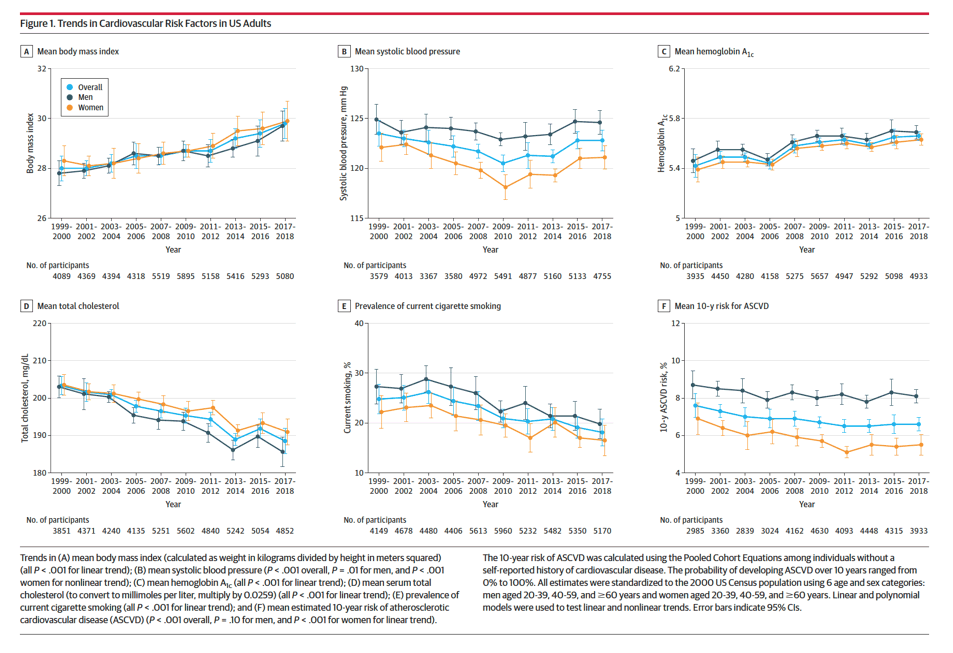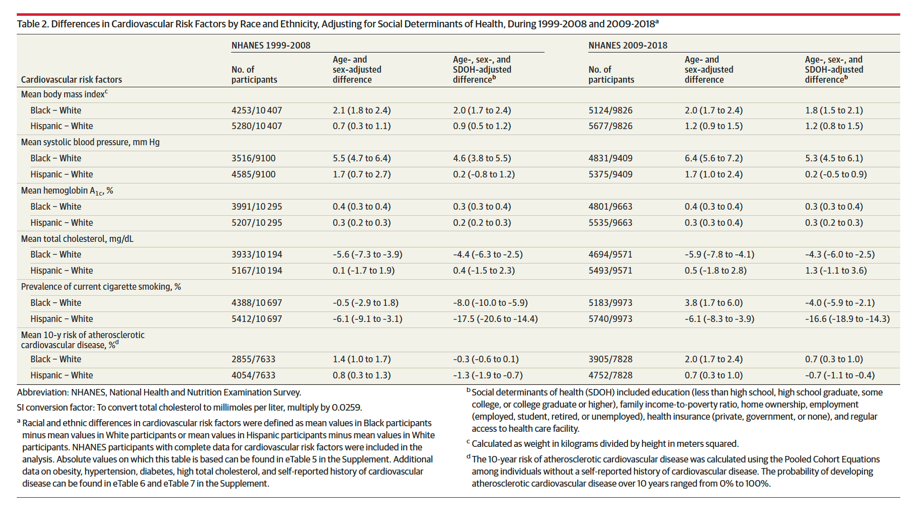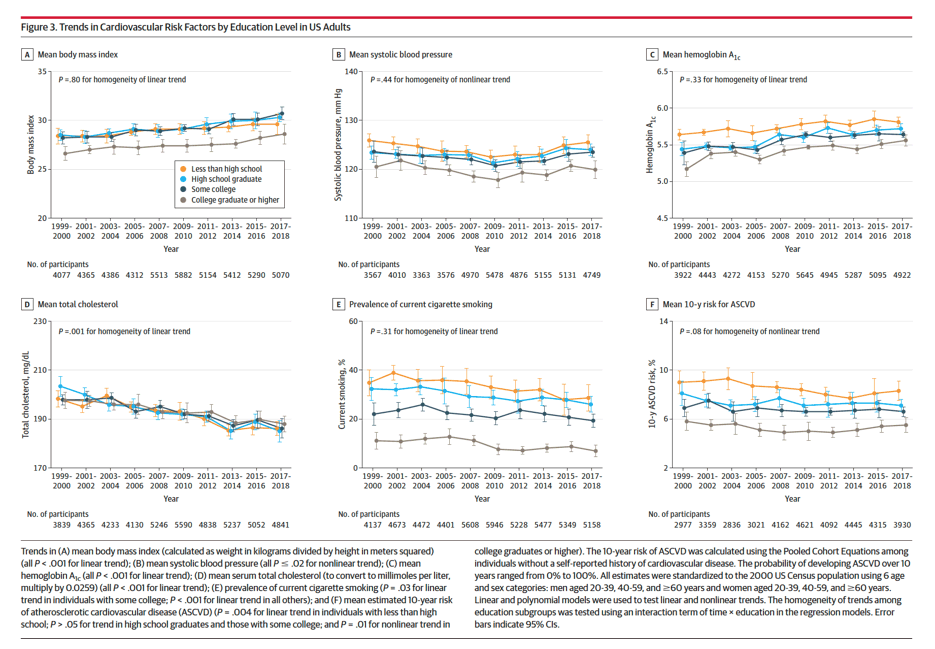| |
Trends in Cardiovascular Risk Factors in US Adults by Race and Ethnicity and Socioeconomic Status, 1999-2018
|
| |
| |
Download the PDF here
Racial and ethnic differences in cardiovascular disease mortality and risk factors have been well documented.28-30 Although cardiovascular disease mortality and risk factors have decreased significantly since 1950, Black persons still have higher risk compared with individuals in other racial and ethnic groups.3,28-30 To our knowledge, this is the first study to report that body mass index, systolic blood pressure, and hemoglobin A1c were persistently higher in the Black population compared with the White population after adjustment for important social determinants of health, such as education, income, housing, employment, health insurance, and access to health care. Other unmeasured social determinants, such as neighborhood and physical environment, access to healthy foods, and social integration, were not included in this analysis but seem likely to play an important role in racial and ethnic differences.11,12,31
Socioeconomic factors, such as educational attainment and family income level, are important social determinants of cardiovascular disease.27,31 Low socioeconomic status, based on household income, education, and employment status, was associated with multivariable-adjusted hazard ratios of 2.3 for cardiovascular disease mortality and 1.7 for cardiovascular disease incidence in the UK Biobank cohort.32
Results The mean age of participants ranged from 49.0 to 51.8 years and the proportion of women from 48.2% to 51.3% in the surveys. From 1999-2000 to 2017-2018, age- and sex-adjusted mean body mass index increased from 28.0 (95% CI, 27.5-28.5) to 29.8 (95% CI, 29.2-30.4); mean hemoglobin A1c increased from 5.4% (95% CI, 5.3%-5.5%) to 5.7% (95% CI, 5.6%-5.7%) (both P < .001 for linear trends). Mean serum total cholesterol decreased from 203.3 mg/dL (95% CI, 200.9-205.8 mg/dL) to 188.5 mg/dL (95% CI, 185.2-191.9 mg/dL); prevalence of smoking decreased from 24.8% (95% CI, 21.8%-27.7%) to 18.1% (95% CI, 15.4%-20.8%) (both P < .001 for linear trends). Mean systolic blood pressure decreased from 123.5 mm Hg (95% CI, 122.2-124.8 mm Hg) in 1999-2000 to 120.5 mm Hg (95% CI, 119.6-121.3 mm Hg) in 2009-2010, then increased to 122.8 mm Hg (95% CI, 121.7-123.8 mm Hg) in 2017-2018 (P < .001 for nonlinear trend). Age- and sex-adjusted 10-year atherosclerotic cardiovascular disease risk decreased from 7.6% (95% CI, 6.9%-8.2%) in 1999-2000 to 6.5% (95% CI, 6.1%-6.8%) in 2011-2012, then did not significantly change. Age- and sex-adjusted body mass index, systolic blood pressure, and hemoglobin A1c were consistently higher, while total cholesterol was lower in non-Hispanic Black participants compared with non-Hispanic White participants (all P < .001 for group differences).
Individuals with college or higher education or high family income had consistently lower levels of cardiovascular risk factors.
The mean age- and sex-adjusted 10-year risk of atherosclerotic cardiovascular disease was significantly higher in non-Hispanic Black participants compared with non-Hispanic White participants (difference, 1.4% [95% CI, 1.0%-1.7%] in 1999-2008 and 2.0% [95% CI, 1.7%-2.4%] in 2009-2018]). This difference was attenuated (-0.3% [95% CI, -0.6% to 0.1%] in 1999-2008 and 0.7% [95% CI, 0.3%-1.0%] in 2009-2018) after further adjusting for education, income, home ownership, employment, health insurance, and access to health care.
Limitations
This study has several limitations. First, NHANES comprises a series of cross-sectional surveys, so longitudinal changes in cardiovascular risk factors at an individual level could not be evaluated. Second, fasting plasma glucose, serum LDL cholesterol, and triglycerides were available for only a subsample of participants. Third, the physical activity questionnaire and dietary intake assessment methods were changed between 1999 and 2018. Therefore, direct comparisons in physical activity and dietary intake among survey cycles were not feasible. Fourth, the Pooled Cohort Equations were not validated in Hispanic or Asian populations. In addition, Hispanic and Asian participants were aggregated into single categories although there were heterogeneities within these racial and ethnic groups. Fifth, due to small sample size, other races were not included in this analysis. Sixth, many important social determinants of health were not measured and could not be included in this analysis.

October 5, 2021
Trends in Cardiovascular Risk Factors in US Adults by Race and Ethnicity and Socioeconomic Status, 1999-2018
JAMA. 2021
Key Points
Question Do secular trends in cardiovascular risk factors differ by race and ethnicity and by socioeconomic status in the US?
Findings In this US serial cross-sectional survey study conducted from 1999 through 2018 that included 50 571 participants, there were significant increases in body mass index and hemoglobin A1c and significant decreases in serum total cholesterol and cigarette smoking from 1999 to 2018. Mean age- and sex-adjusted estimated 10-year risk of atherosclerotic cardiovascular disease was constantly higher in non-Hispanic Black participants compared with non-Hispanic White participants, but this difference was attenuated after further adjusting for education, income, home ownership, employment, health insurance, and access to health care.
Meaning In a national US survey study from 1999 to 2018, differences in cardiovascular risk factors persisted between Black and White participants; the difference may be moderated by social determinants of health.
Abstract
Importance After decades of decline, the US cardiovascular disease mortality rate flattened after 2010, and racial and ethnic differences in cardiovascular disease mortality persisted.
Objective To examine 20-year trends in cardiovascular risk factors in the US population by race and ethnicity and by socioeconomic status.
Design, Setting, and Participants A total of 50 571 participants aged 20 years or older from the 1999-2018 National Health and Nutrition Examination Surveys, a series of cross-sectional surveys in nationally representative samples of the US population, were included.
Exposures Calendar year, race and ethnicity, education, and family income.
Main Outcomes and Measures Age- and sex-adjusted means or proportions of cardiovascular risk factors and estimated 10-year risk of atherosclerotic cardiovascular disease were calculated for each of 10 two-year cycles.
Results The mean age of participants ranged from 49.0 to 51.8 years and the proportion of women from 48.2% to 51.3% in the surveys. From 1999-2000 to 2017-2018, age- and sex-adjusted mean body mass index increased from 28.0 (95% CI, 27.5-28.5) to 29.8 (95% CI, 29.2-30.4); mean hemoglobin A1c increased from 5.4% (95% CI, 5.3%-5.5%) to 5.7% (95% CI, 5.6%-5.7%) (both P < .001 for linear trends). Mean serum total cholesterol decreased from 203.3 mg/dL (95% CI, 200.9-205.8 mg/dL) to 188.5 mg/dL (95% CI, 185.2-191.9 mg/dL); prevalence of smoking decreased from 24.8% (95% CI, 21.8%-27.7%) to 18.1% (95% CI, 15.4%-20.8%) (both P < .001 for linear trends). Mean systolic blood pressure decreased from 123.5 mm Hg (95% CI, 122.2-124.8 mm Hg) in 1999-2000 to 120.5 mm Hg (95% CI, 119.6-121.3 mm Hg) in 2009-2010, then increased to 122.8 mm Hg (95% CI, 121.7-123.8 mm Hg) in 2017-2018 (P < .001 for nonlinear trend). Age- and sex-adjusted 10-year atherosclerotic cardiovascular disease risk decreased from 7.6% (95% CI, 6.9%-8.2%) in 1999-2000 to 6.5% (95% CI, 6.1%-6.8%) in 2011-2012, then did not significantly change. Age- and sex-adjusted body mass index, systolic blood pressure, and hemoglobin A1c were consistently higher, while total cholesterol was lower in non-Hispanic Black participants compared with non-Hispanic White participants (all P < .001 for group differences). Individuals with college or higher education or high family income had consistently lower levels of cardiovascular risk factors. The mean age- and sex-adjusted 10-year risk of atherosclerotic cardiovascular disease was significantly higher in non-Hispanic Black participants compared with non-Hispanic White participants (difference, 1.4% [95% CI, 1.0%-1.7%] in 1999-2008 and 2.0% [95% CI, 1.7%-2.4%] in 2009-2018]). This difference was attenuated (-0.3% [95% CI, -0.6% to 0.1%] in 1999-2008 and 0.7% [95% CI, 0.3%-1.0%] in 2009-2018) after further adjusting for education, income, home ownership, employment, health insurance, and access to health care.
Conclusions and Relevance In this serial cross-sectional survey study that estimated US trends in cardiovascular risk factors from 1999 through 2018, differences in cardiovascular risk factors persisted between Black and White participants; the difference may have been moderated by social determinants of health.


|
|
| |
| |
|
|
|